Business travel is like a box of chocolates. You never know when you're going to get the middle seat.
For many companies, corporate travel is a source of profitable deals, long-lasting partnerships, and networking opportunities – as well as huge expenses. For the record, globally, over $1 trillion per year is spent on business travel.
It’s also a source of sleepless nights for travel managers. Balancing cost-effectiveness, employee comfort, and policy compliance is a challenge for businesses of all sizes. This is where corporate travel programs and specialized software solutions step in.
In this post, we'll explore the role of these programs in business travel and look at how to create, structure, and implement them. We’ll also discuss software that can support corporate travel programs and describe some life-saving tools for a travel manager.
But first, let’s take a step back and talk about how the world of corporate travel functions, its main players, and how they are intertwined. If you’re familiar with this complex construction, feel free to skip this section.
Learn about corporate travel cards and how businesses use them to handle employees' travel and expense (T&E) management.
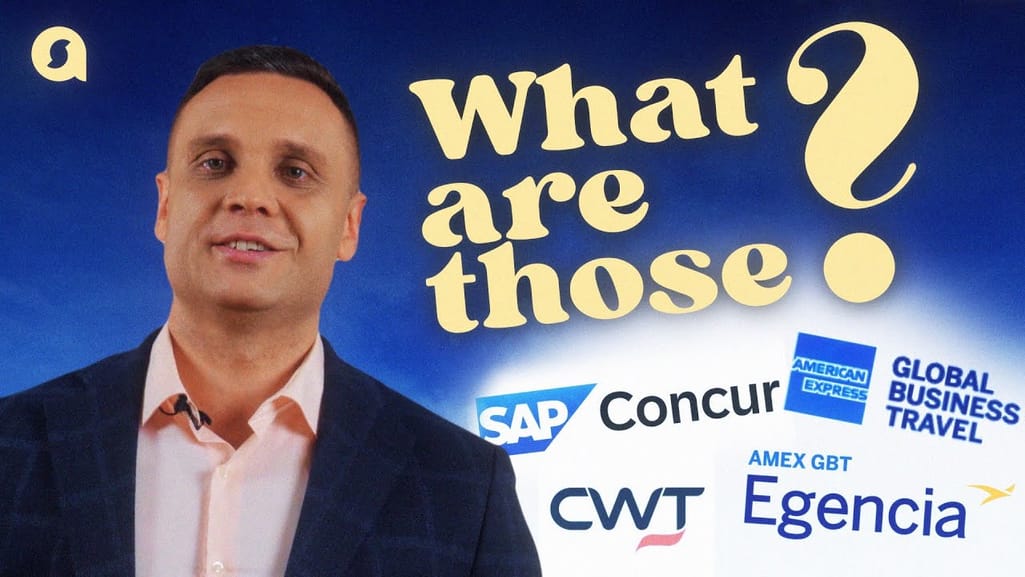

Watch our expert explain how corporate travel works
How corporate travel works
Before we describe the processes and interaction options, let’s look at who's who in the corporate travel universe.
Key players in the corporate travel market
If you’re a travel manager responsible for organizing business trips for your company’s employees, you most probably work with at least one of the groups we’re about to discuss.
Service providers like airlines, hotels, or car rentals are obviously one of the main stakeholder groups in the corporate travel world that you inevitably deal with – directly or via intermediaries.
Travel inventory aggregators and resellers are another important category, serving as middlemen between travel service providers and travel agencies or even corporations themselves. These intermediaries source travel products directly from suppliers, providing access to a big pool of travel inventory at lower fares.
Global distribution systems (GDSs) are the most prominent representatives of this category, as they are the largest inventory aggregators and are most engaged in corporate travel bookings. Airline consolidators, bed banks, OTAs, and flight aggregators also have their share but to a lesser extent.
Tech providers that develop such solutions as online booking tools (OBTs) and travel and expense (T&E) management systems are another big group of players. They offer automation, transparency, and self-service, helping travel managers make bookings and, importantly, track expenses from all business trips. Besides, they enable employees to book their trips themselves and pay with a corporate credit card (physical or virtual) or conveniently submit their expenses for reimbursement if paid out of pocket.
SAP Concur, Navan, and Egencia are some of the big names in this category.
Travel management companies (TMCs) specialize in arranging business travel for their clients. They source travel inventory from aggregators and/or negotiate discounted rates with service suppliers, plus provide additional services like insurance, on-trip assistance, etc. They also offer tech solutions to handle all travel aspects, from booking to reporting.
So basically, those are the main players in this market: companies that want their employees to travel safely and productively, actual service suppliers (hotels, airlines, car rentals, etc.), aggregators of travel inventory, tech providers who develop software to streamline workflows, and TMCs that offer their expertise in this field.
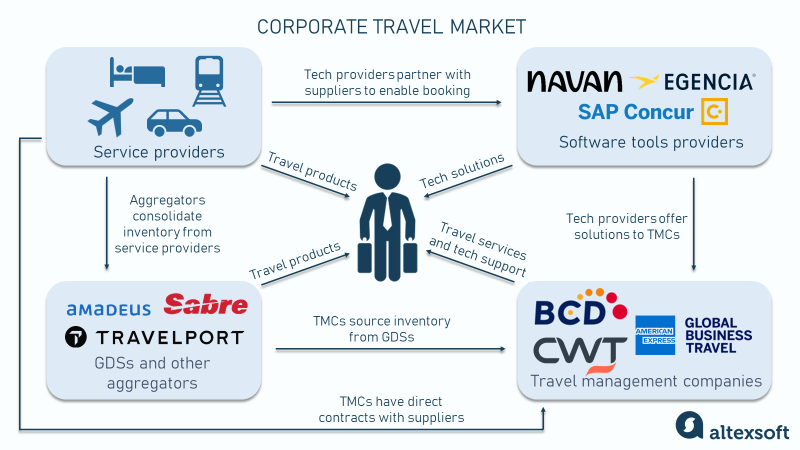
Seems simple so far? Well, it’s actually not. Let’s take a deeper dive and see how these parties interact with each other.
Multiple interaction scenarios
There are numerous scenarios of how companies handle business travel. Let’s look at the most common ones.
Corporation – OTAs/travel suppliers. If you work in a small company, you probably just go straight to one of the booking websites (like Skyscanner, Kayak, or Expedia) and select all the travel components there, including flights, lodging, and transfer. Alternatively, you might book each element separately – directly from the airline, hotel, etc.
In many cases, employees make all their travel arrangements themselves and submit their expenses for reimbursement after the trip.
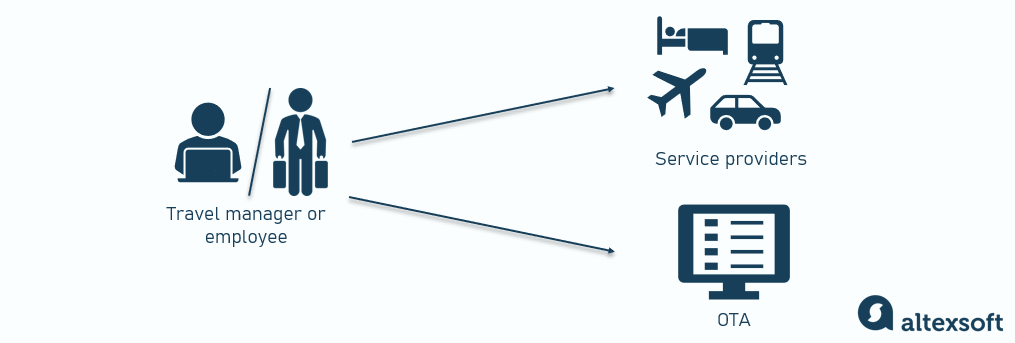
Corporation – tech provider. As the company grows, manual travel management becomes too complex, time-consuming, and inefficient. So many organizations implement a T&E management solution to digitize this process. As we described above, these tools support diverse booking options, simplify expense reimbursement, enable transparent tracking, generate spending reports, and so on.
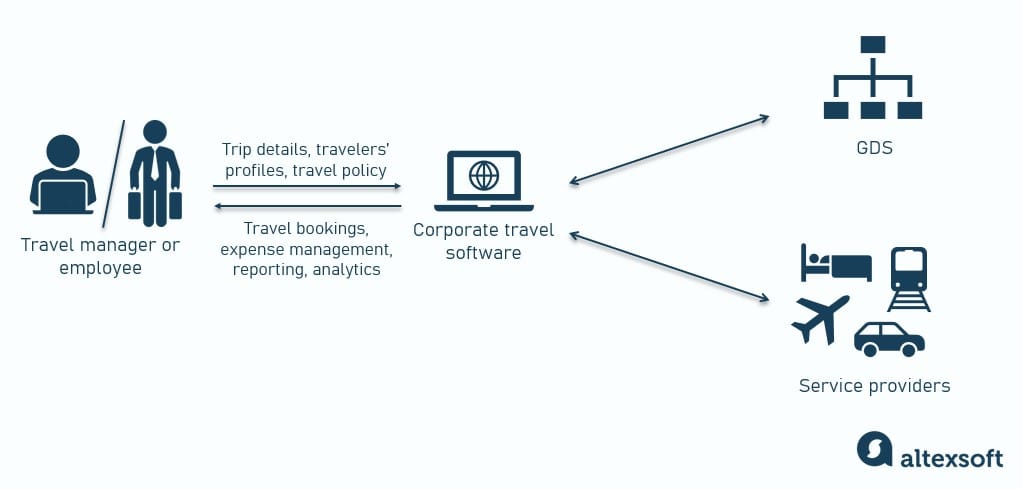
Managing travel through a T&E solution
Corporation – TMC. Another way growing companies can cope with increased workloads is delegating travel management to a TMC. If you partner with third-party experts, you first get them acquainted with your travel policy and then send them requests with all the trip details. To make all the necessary arrangements, the TMC probably turns to the GDS inventory or exploits direct contracts with suppliers.
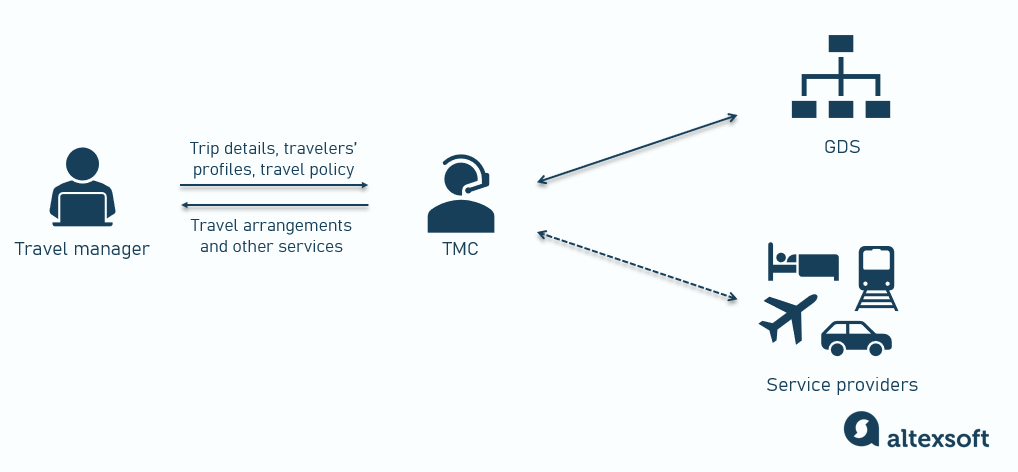
Booking travel through a TMC
Corporation – TMC – tech solutions. Huge, multinational corporations usually have an intricate tangle of requirements and policies that they have to follow. So they often employ a combined approach, implementing a complex tech ecosystem and working with a TMC – or even several of them. For example, they can outsource making arrangements to external agents but use a T&E management tool for better spending visibility and advanced analytics.
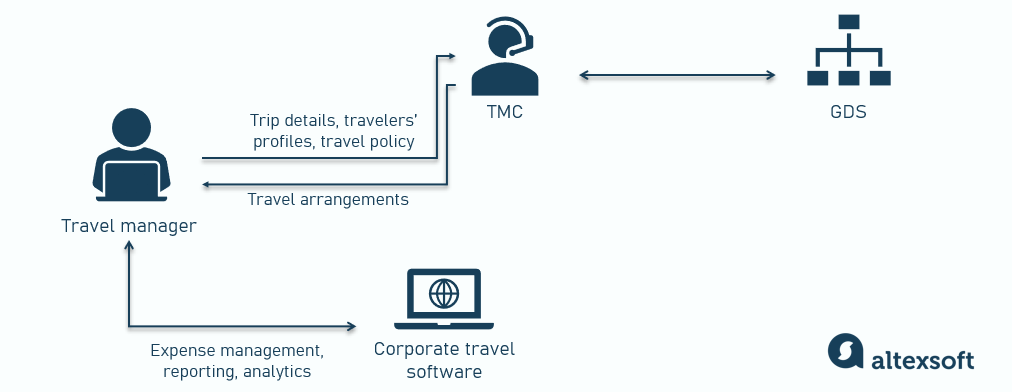
Managing travel through a TMC and software
Let’s look at a real-world example. In 2022, the companies with the biggest travel spend were Amazon, FedEx, The Walt Disney Co., and Lockheed Martin. To better understand the scale, in 2020, Amazon saved $1 billion in business travel expenses as they cut down nonessential travel because of COVID restrictions. Impressive, isn’t it?
Amazon used to work with CWT as its main travel vendor. However, in 2023, it moved to BCD Travel – but only partially, leaving the lodging segment to CWT’s RoomIt division. In addition, Amazon has Concur as its T&E management software partner.
With its budget and options, the retail/tech giant still prefers to outsource the corporate travel management hassle rather than handle it in-house – just like many others. So what is the value that TMCs offer to corporations?
The role of TMCs
Apart from sparing its employees the constant stress of dealing with never-ending changes and last-minute requests, here’s why big companies turn to TMCs.
Wide range of services including
- ability to handle complex itineraries due to vast supplier networks and connections to GDSs;
- turn-key travel arrangements, including visas, insurance, leisure activities, or exclusive services like a helicopter transfer or pet care;
- savings due to specially negotiated airfares and hotel rates, perks, and extras;
- personalized 24/7 on-trip assistance and disruption management, i.e, making last-minute arrangements, rebooking flights, or finding alternative options in case things go unplanned;
- travel policy development and compliance;
- tracking and analyzing expenses, thus providing greater visibility into spending;
- organizing MICE, booking venues, planning events, and much more.
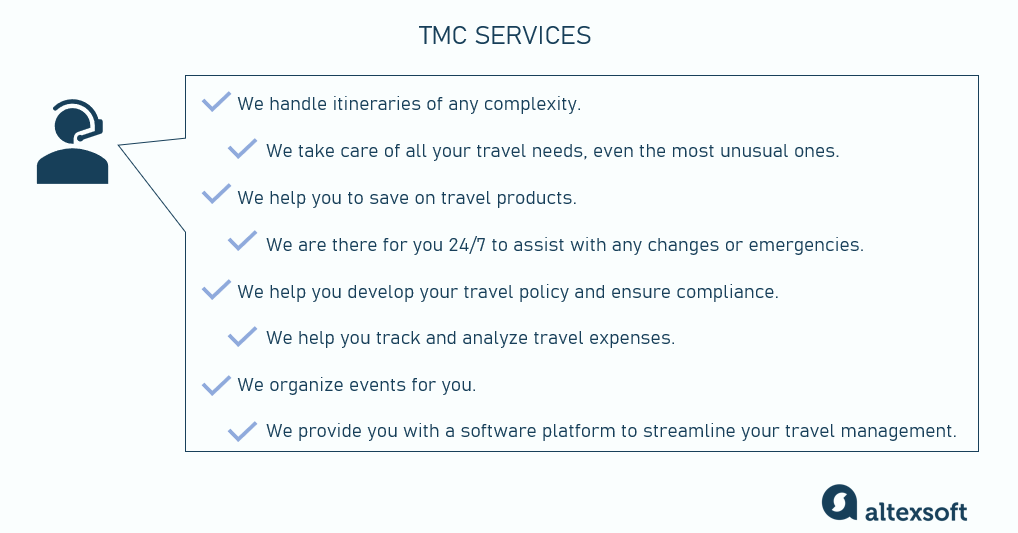
To deliver a superior, personalized experience, TMCs create a centralized database of their corporate clients’ profiles that contain all the personal details of traveling staff, policy rules, travel history, loyalty program information, etc.
Tech support. As we’ve already mentioned, TMCs often provide proprietary tech solutions to help their clients digitize travel management. They can also employ off-the-shelf tech solutions from market providers.
Sometimes, TMCs partner with tech providers and offer a variety of tools to their clients, depending on their needs and existing tech infrastructure. Besides, they are usually ready to integrate with different software systems in case the client uses a custom-built platform.
Convenient payments. Another advantage of TMCs is the ease of payments. Depending on the terms you set up, you can pay a consolidated invoice for travel services once a month/quarter instead of dealing with separate transactions for every booking made.
As you can see, as experts in the realm of corporate travel and having a wide range of services, TMCs go the extra mile to provide maximum value for their clients.
For more information, visit our detailed overview of corporate travel management companies.
So now that you, hopefully, have a better understanding of how the business travel universe is organized, let’s finally talk about the corporate travel program.
What is a corporate travel program?
A corporate travel program basically formulates the company’s overall approach to business travel. It describes all related aspects such as the scope of support for travel arrangements, partnerships with travel service providers, access to booking tools, and so on.
Besides, corporate travel programs define the roles and responsibilities of travel managers, be it an internal travel management department or a third-party TMC. However, if a company outsources all of its corporate travel management, there’s no need to develop a full-fledged program.
Corporate travel programs aim to streamline the process of organizing business trips, as well as ensure cost-efficiency, policy compliance, and traveler comfort and safety. Speaking of policies, a corporate travel program might seem a lot like a travel policy, but it’s more than that. Let’s look at how they are different.
Corporate travel program vs travel policy
A corporate travel program is a broader concept than a travel policy, which is a set of specific rules and guidelines that company employees must follow while traveling for business. We’ll describe what’s usually included in a travel policy in one of the next sections.
So while a travel policy sets the boundaries within which travel should take place, a travel program provides the holistic framework for arranging and managing travel. The policy is about guidelines and limits, while the program is about the execution of travel policy and overall management.
How to create and implement a corporate travel program?
Obviously, the elements of a corporate travel program will vary across businesses. You’ll have to develop your own based on your company’s size, travel needs, and overall strategy. Here, we suggest the common building blocks that you can tailor to your circumstances.
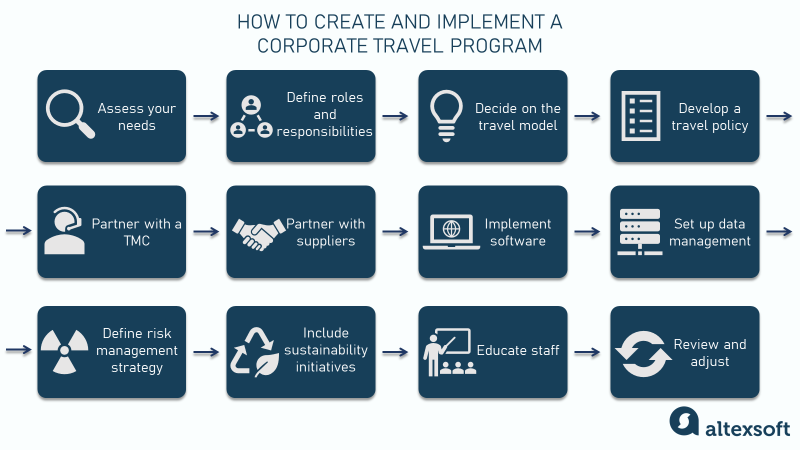
Assess your needs
Before jumping into any project, assess the current situation. Analyze your company’s travel needs, spending, and processes to identify requirements and areas for improvement. Also, define the traveler types within your company and consider how you can address their needs:
- road warriors vs. infrequent travelers,
- global vs. domestic travelers,
- travelers from different countries (if your company has multinational bases),
- travelers of different ages, physical conditions, and so on.
Be sure to ask for feedback from your employees. The knowledge of the current state of affairs and needs will define the starting point of your travel program development.
Define roles and responsibilities
Decide who’s going to take care of your travel processes, i.e., an internal travel management department or a third-party TMC. Note that even if you outsource these activities, you still have to designate the people responsible for overseeing them within your company.
You can start by deciding on the organizational structure, i.e., which C-level manager is responsible for your corporate travel. Typically, it’s the CFO or head of HR. Overall support and buy-in from this executive is crucial for program development and implementation. Also, secure the backing from regional leaders and branch executives.
So who else is involved in travel-related workflows?
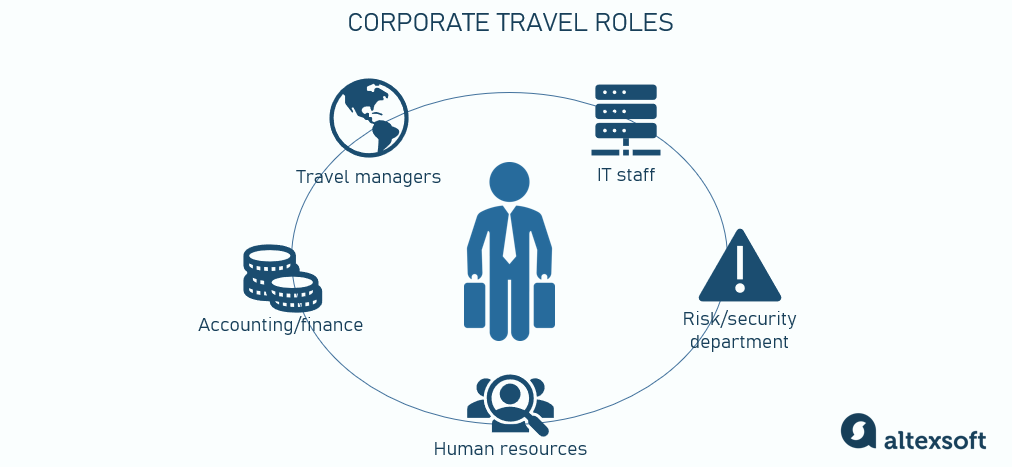
Travel manager(s). Whether it’s a single staff member or an entire department, you need someone to oversee all corporate travel activities. These employees will administer the program, manage partners and suppliers, and be the primary point of contact for all stakeholders.
Accounting/finance team. Since they control the money flow, they take part in travel budgeting, expense tracking and reimbursement, and overall cost management.
IT staff. If you implement travel software, you’ll need someone to maintain and manage it.
HR department. Human resource staff can help with developing the travel policy and employee communications.
Risk/security department. If you have a separate team responsible for safety and security, involve them in developing travel-related risk management protocols. If not, the HRs can perform this function.
All these teams, each with their own tasks and priorities, will build up a stakeholder network. As you develop and implement the travel program, collaborate with them closely. Gather ideas and feedback from both managers and operating units to improve your program.
Decide on the travel model
You must outline the company’s general approach to managing travel. Basically, decide on how you want travel to be booked and paid for. Depending on the roles and limitations you plan to employ, here are some models to consider.
The mandated model is the least flexible, providing strict policy rules, concrete reporting procedures, specified payment methods, a limited list of booking channels and suppliers, and so on. It usually means partnering with a TMC to centralize all travel activities.
As a rule, it’s easier to manage travel and track expenses in this model, but employees may be unhappy about tight restrictions and limited opportunities to use loyalty programs.
The flexible or open booking model sits on the opposite side of the spectrum, giving employees and travel managers maximum freedom in choosing suppliers, booking channels, and payment methods, while still limiting the budget. The shining example here is Netflix with its famous five-word travel/expense policy: "Act in Netflix's best interests."
This model is usually more convenient for travelers seeking flexibility. Still, it complicates data gathering and expense tracking, limits savings possibilities from working with partner suppliers, and reduces TMC-provided on-trip assistance.
In between sit multiple hybrid models that employ a combined approach.
Note that the model you choose will determine what your data gathering, expense reporting, and compliance tracking procedures will be.
When defining your approach, we recommend conducting internal stakeholder meetings as well as market research. Look at travel practices that other companies of similar size and sector adopt.
Once you outline your overall vision of corporate travel, you have to put it into words in a travel policy.
Develop a travel policy
A travel policy aims to standardize travel-related procedures, manage corporate expenses, and provide employees with an understanding of reimbursable costs to avoid unwelcome surprises. Outlining the main rules and guidelines, it serves as a basis for your corporate program.
That’s why designing a detailed, comprehensive travel policy based on your company’s strategy is an absolute must. Consider including the following aspects:
- pre-trip approval process;
- budget limits and per diem guidelines;
- preferred travel providers and class of service;
- expenses that are reimbursable (or not);
- post-trip reporting and reimbursement procedures;
- duty of care, emergency information, and travel support;
- use of loyalty programs;
- leisure extensions;
- use of a corporate credit card, and so on.
A simple Google search will provide you with plenty of free policy templates you can use to create your own. Depending on your company’s needs and processes, you can make it as simple as the ones from Workable or PandaDoc or as detailed as the ones from SHRM or TravelPerk.
Once it’s ready, make sure the policy is accessible to all stakeholders.
Partner with a TMC
IF you decide to outsource some or all of your corporate travel activities, you have to find a reliable partner. How to choose a TMC can be the topic of a dedicated post, so here we’ll only give you a few tips on which factors to consider. Needless to say, your own criteria might differ as they will depend on the scope of outsourced activities.
Range of services. Besides booking travel services, what else do they offer? Disruption management (and what exactly is included?), insurance and visa support, discounts on travel products, multi-language human assistance 24/7 – be sure to know what you can count on.
Partner list. Some TMCs only partner with a few suppliers and won’t be able to provide you with sufficient travel options. Compare their providers with your policy and check, for example, if they work with low-cost airlines or business hotels near convention centers your employees need to visit.
Expense management. Carefully inspect their T&E management processes to be sure they are transparent and support your cost optimization strategy.
Software implementation. Which tech tool do they offer? Does it integrate with your existing systems, and who’s responsible for setting up the integration? Does it cover all the workflows (communication, reporting, documentation exchange, etc.) so that you won’t have to email or call the agents? How long will it take to implement the software and train staff? If you use your own software, are they ready to integrate with it?
Pricing model. Depending on your travel volume, you might want to go with a subscription program or a per-trip fee model. Make sure there are no hidden charges, e.g., for agent support or international calls.
You might also want to consider creating a business account on one of the OTAs. It’s a viable option for small or mid-size companies that can’t afford full-scope TMC support. For example, Booking.com for Business is a suite of services for corporate travelers that includes an online booking and travel platform, corporate discounts, and 24/7 manager assistance from CWT. Their platform enables traveler mapping, expense reporting, and the ability to manage bookings for multiple travelers – which might be sufficient for your needs.
For large, multinational corporations, it might make sense to work with several TMCs. You might choose to partner with several agencies from different locations or divide your travel operations, for example, into air travel, lodging, and other segments (remember the Amazon example we mentioned above?).
Of course, such diversification has its pros and cons. On one hand, it offers cost-saving opportunities from optimized supplier networks or facilitated payment procedures in different countries. On the other hand, having a single, centralized account with one TMC is more convenient in terms of overall coordination, data capturing, expense tracking, and so on.
Partner with suppliers
You might want to negotiate contracted terms directly with travel providers and save a penny or two with corporate rates and discounts. Obviously, this part is also optional, especially if you prefer to arrange corporate travel through a TMC.
Consider such a partnership if you use the same provider often. For example, if you know that a big part of your business travel is going to the same location, find a conveniently placed hotel and see if you can secure more favorable prices for frequent visitors.
Implement software
Depending on your needs and workflows, choose and implement technology solutions that support the travel program and ensure more efficient travel management and expense reporting. The two main types of software are online booking tools (OBTs) and travel and expense (T&E) management solutions. This part deserves a separate section, so we’re going to discuss them in more detail a bit later.
Set up data management, reporting, and analytics processes
Setting up proper data management practices is crucial for making the most of available information. It’s a multi-component strategy that, if implemented right, will enable making informed, data-based decisions guiding future development.
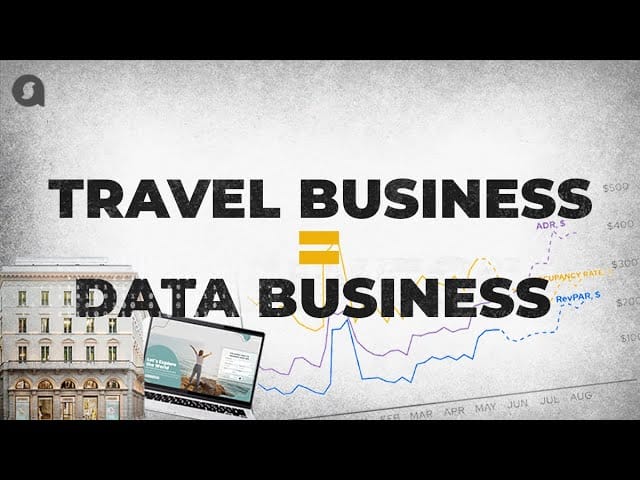

Check out our recent overview of data management in travel
First, look at your data sources. It may be your internal systems, suppliers’ information, TMC data, or external market sources. Then, define and fill in the gaps, e.g., set up systems for tracking travel spending and/or analyzing travel patterns.
Consider implementing a business intelligence platform that will help you analyze and visualize collected data. You might want to scrutinize cost structure, supplier performance, disruption occurrences, or other aspects of your corporate travel.
Use obtained insights to optimize the travel program, cut spending, negotiate with vendors, tailor profile records, and enhance risk management.
Define risk management strategy
We mentioned duty of care as an essential part of the travel policy, but we want to emphasize the importance of developing a comprehensive risk management strategy.
Risk management includes taking both proactive and reactive measures to avoid threats. It covers everything from alerting travelers of disruptions to informing them about local dangerous areas to emergency support.
Consider implementing risk management software and leveraging data to have real-time information on the traveler’s location and possible disruptions.
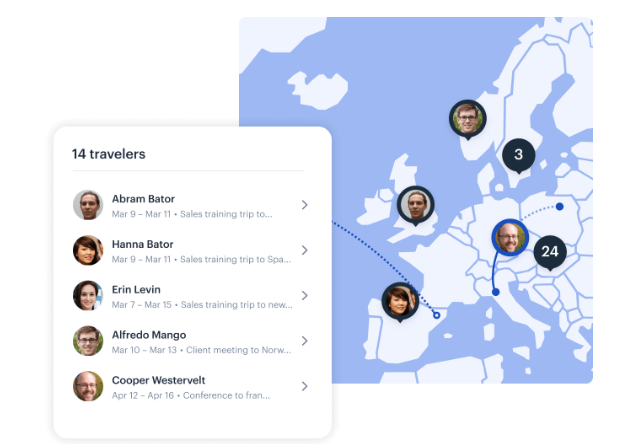
Efficient disruption management in business travel is crucial. Check out the case study on AltexSoft developing a disruption management system for Cornerstone Information Systems, a corporate travel tech provider.
Include sustainability initiatives
Incorporate sustainable travel practices and emission reduction strategies into the program, such as prioritizing eco-friendly accommodations and carbon-neutral transportation, to align with corporate social responsibility goals.
Educate staff
Communicate the policy and overall program across operational units and affiliates. Train employees on the new travel program, policies, and tools. Ensure everyone understands how to book travel and report expenses under the new system. Continuous, transparent communication is vital for ensuring compliance and gathering feedback.
Review and adjust
A corporate program isn’t static and should evolve with your company. Create mechanisms for receiving feedback from travelers and other stakeholders. Regularly assess the travel program's performance, including compliance with the travel policy, traveler satisfaction, and cost savings. Use this data to adjust and improve the travel program.
Make sure your program consistently contributes not only to employee safety and productivity but also to company goals and initiatives like cost and value optimization, process digitization, or carbon emissions reduction.
We hope that now the entire project of developing and implementing a corporate travel policy doesn’t seem as intimidating. Now, as promised, we'll talk about the tech. We kept mentioning the importance of technology in corporate travel management, so let’s see how it can support your travel program.
Corporate travel management software
As we said, regardless of whether you work with a TMC or have your internal travel managers handle all the hassle, it’s still worth implementing specialized software to streamline operations and data exchange. Technology can help you address the common challenges of managing business travel such as cost control, policy compliance, traveler support, data analysis, and so on. Not to mention making travel arrangements themselves, of course.
Now which tools can support your corporate travel program? There are two main groups – online booking software and expense management software – but please note that the line between them is blurring more and more.
While some platforms still have narrow-focused functionality, many tech providers today strive to develop comprehensive products to cover all business needs. In the comparison table below, you’ll see that all the top software suppliers offer multifeatured solutions with both booking and expense management functionality.
Also, to stay competitive, tech vendors continuously look for ways to enhance their products, adding ML/AI to make personalized travel recommendations, identify fraud, enhance analytics, and so on.
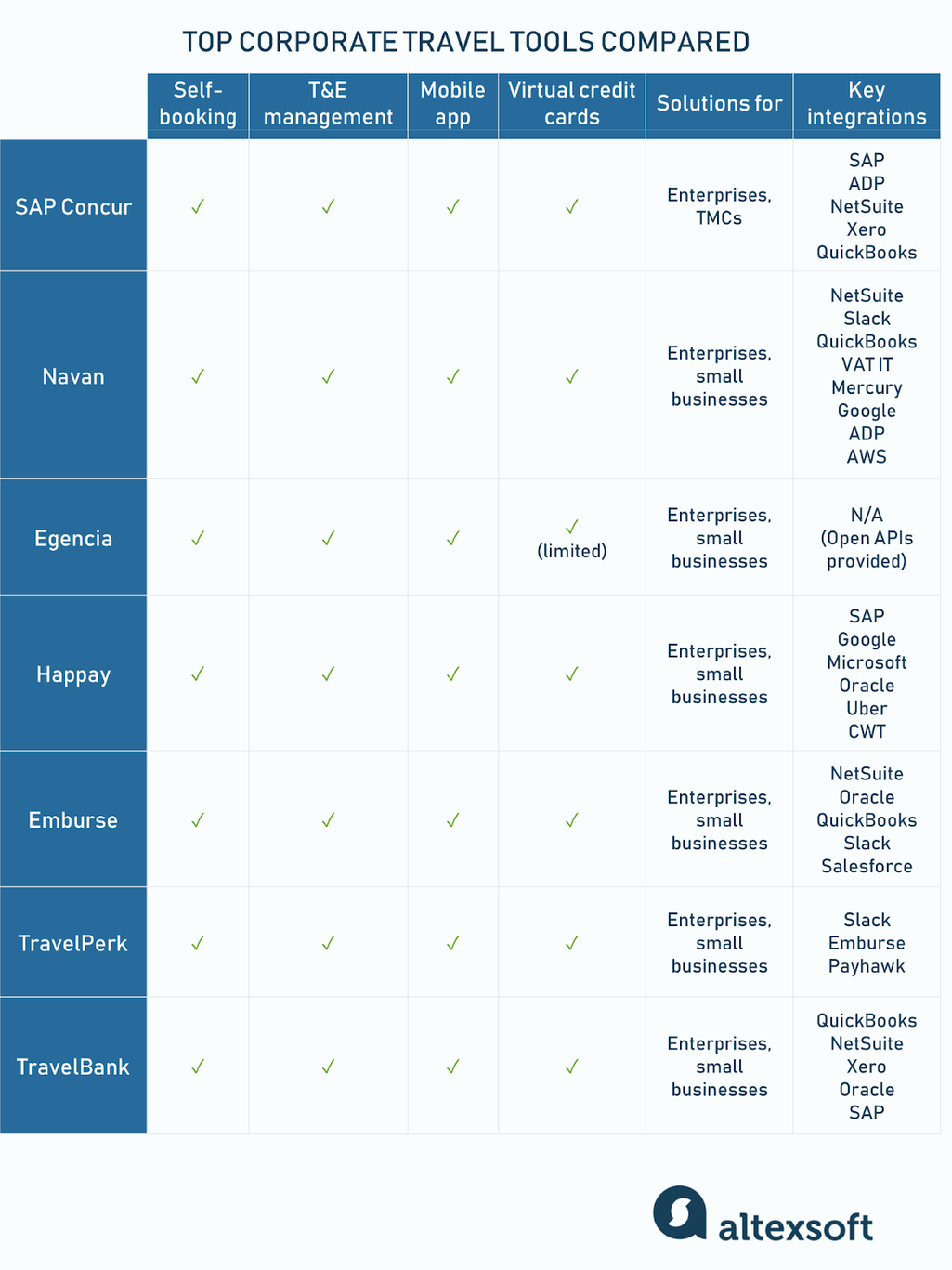
You can read more about B2B corporate travel platforms in our dedicated post.
Corporate booking tool
The corporate booking tool or online booking tool (OBT) is a software platform companies use to manage business travel. An OBT streamlines arranging flights, hotels, car rentals, and other travel services for employees.
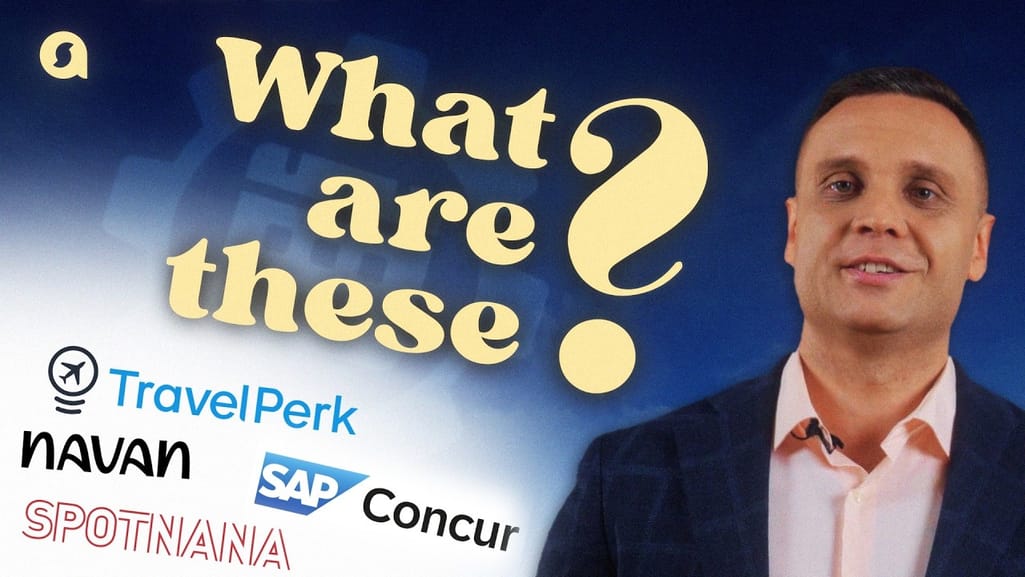

Kirill Stati, Managing Director of Travel Tech at AltexSoft, explains OBTs
An OBT is different from, say, an OTA’s B2C booking engine as it always incorporates the company’s travel policy and a traveler profile database. So basically, this tool dictates which products you can book, from which sources, at which prices, etc. This way, it aligns with the company’s travel policies, ensuring all bookings adhere to set budgets and travel guidelines.
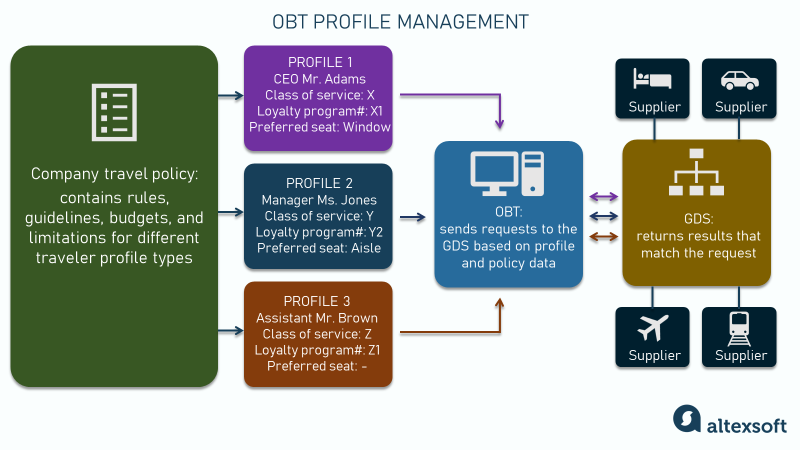
Besides booking travel services, as we said, many OBTs offer other handy functionality. So the key features of a modern corporate booking tool are
- booking travel,
- itinerary management,
- compliance monitoring,
- expense tracking,
- risk management, and
- reporting.
There are two main scenarios for implementing and using an OBT.
On the company side. You might want to implement an OBT for managing your company travel yourself. Being highly customizable, the system is configured to align with the company’s travel policy, inventory suppliers, etc. Also, it’s typically integrated with other systems (ERP, HR/CRM software, financial systems, etc.) to facilitate data exchange and reporting procedures.
Depending on who makes travel arrangements, you can set up different access levels. For example, you might want only travel managers to manage bookings. Or you can enable self-service and allow your employees to arrange their travel. You can also provide your TMC partner access to your tool. This way, the OBT can allow any party (travel managers, employees, and TMC representatives) to make bookings and manage them in one centralized system.
On the TMC side. If you outsource travel arrangements to a TMC, you might not want to buy an OBT for yourself. In this case, you rely on the booking tool that your partner owns and maintains on their side.
To manage your travel, a TMC creates a separate account for your company within its OBT – with your travel policy and profile database. Depending on your agreement terms, you might have limited access to their platform to manage your company’s travel, adjust profiles, view reports, and so on.
Travel and expense (T&E) management software
T&E management, as the name suggests, mainly focuses on monitoring travel expenses rather than handling bookings. T&E management software allows you to
- conveniently submit expenses for reimbursement,
- issue virtual credit cards with enhanced spending control and fraud protection,
- generate travel expense reports, and
- analyze business travel spending.
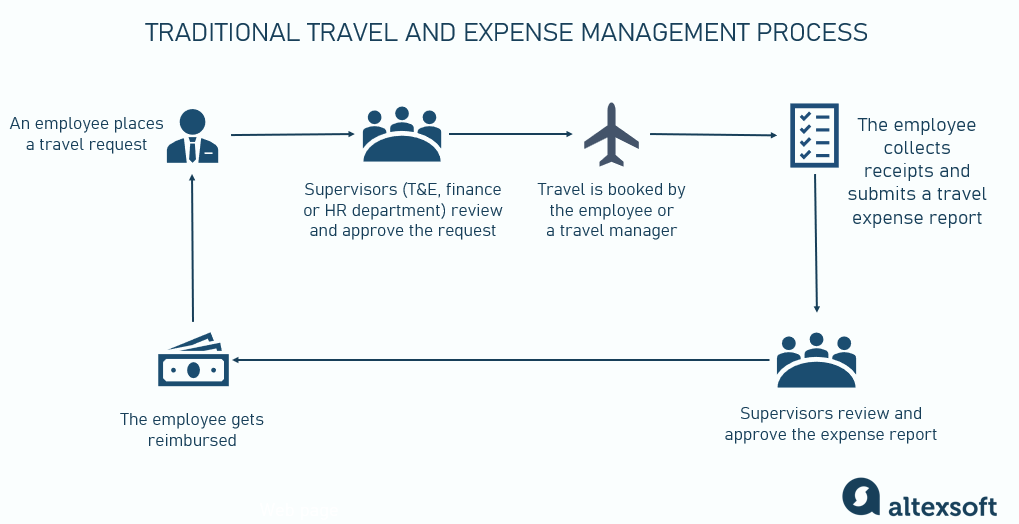
How T&E management works
However, there are many modular T&E tools that you can configure on your own, choosing the functionality that you need to fill in the automation gaps. To have a single, end-to-end platform, you can add the booking and policy compliance modules, invoice automation functionality, and so on, depending on what the tech provider offers.
Just like with the OBT, you can implement your own T&E management tool, maintain it on your side, and integrate it into your existing IT infrastructure – or go with the platform provided by the TMC you work with.
How to choose corporate travel management software
To wrap up, we have a few tips on how to evaluate existing options and choose the right software. First things first, as always, carefully assess where you’re at. Here are some of the questions to answer.
- How big is your company, how many people travel, and how often?
- Who makes bookings and manages business travel? Do you need self-service functionality?
- How do you manage corporate travel now? Do you have any specialized software in use? Which processes need to be automated?
- Which other systems do you have that you need to integrate with travel management software?
Once you understand your needs and pain points, you can explore the market and look at the options. When comparing, pay attention to the following factors:
- functionality and pricing (ask about demos and/or free trials),
- customization options (how smoothly the tool can fit your workflows),
- integration options (check if there are any prebuilt connections or if the provider can assist you with developing the ones you need),
- data security (ask who owns the profile data and how securely it’s handled),
- reviews (check forums, online overviews, and review aggregators to gather feedback from existing users), and
- customer and tech support (you’ll need it, trust us).
As you wade through the tech providers’ brochures and sales rep’s emails, you might find out that no off-the-shelf solution is good enough. In this case, consider developing your own, proprietary software. Though it’s definitely a lengthy and costly project, a custom-built platform will seamlessly cover your workflows and meet your business needs, helping you take your corporate travel management to the next level.

